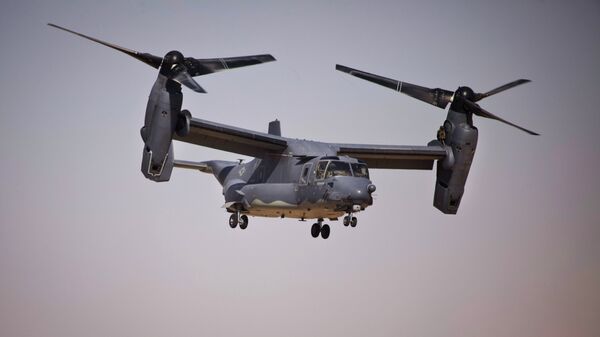The US military is remaining open to new ideas for how the service can continue to innovate. “Anything new,” is within the scope of the military to "entertain," former US Marine and current tiltrotor executive at the Boeing Company John Parker told Military.com on March 29.
The next wave of science-fiction, futuristic weapons systems might rework the entire notion of what weapons should do in combat. "Nonlethal-type weapons, like sonic waves or sound waves" are just a sample of what Boeing is presenting to the Pentagon.
"We’re looking at all sorts of things," Parker told National Interest. "Everything is an option."
The V-22 combines the capabilities of vertical lift, like helicopters, and the forward flying motion of jets. The Defense Department initially drew up plans to buy 458 V-22s, according to a Congressional Research Service brief from 2011.
In the wake of the Iranian hostage crisis, military analysts said that a new aircraft was needed to shore up capabilities gaps. Namely, the Pentagon wanted a high-speed, vertical takeoff aircraft that could take on longer range missions. “The Osprey’s speed allows for deep penetration missions under cover of darkness," writes Daniel Goure of the Lexington Institute.
According to Bell and Boeing, the makers of the Osprey, the tiltrotor has a range of 1,011 miles. It was introduced in 2007 as the first tiltrotor aircraft.
Nevertheless, the aircraft still poses "a number of potential oversight issues" with reliability, maintainability, and perhaps most significantly, "operational suitability," the CRS notes.
The laser-armed Ospreys could make their way into foreign air force fleets. At a cost of roughly $70 million per aircraft, Boeing may do “another 100 sales” to countries like the United Arab Emirates, Japan, Israel, Qatar, Italy, the UK and Australia, Global Security reported.
Veteran V-22 pilots within the US armed forces are becoming scarcer by the day. The number of seasoned aviators within the services has nosedived by about 20,000, from 202,000 to 182,000, Sputnik reported. As a result, military brass have offered retention bonuses to keep air crews from hopping ship to more lucrative roles in the private sector.




